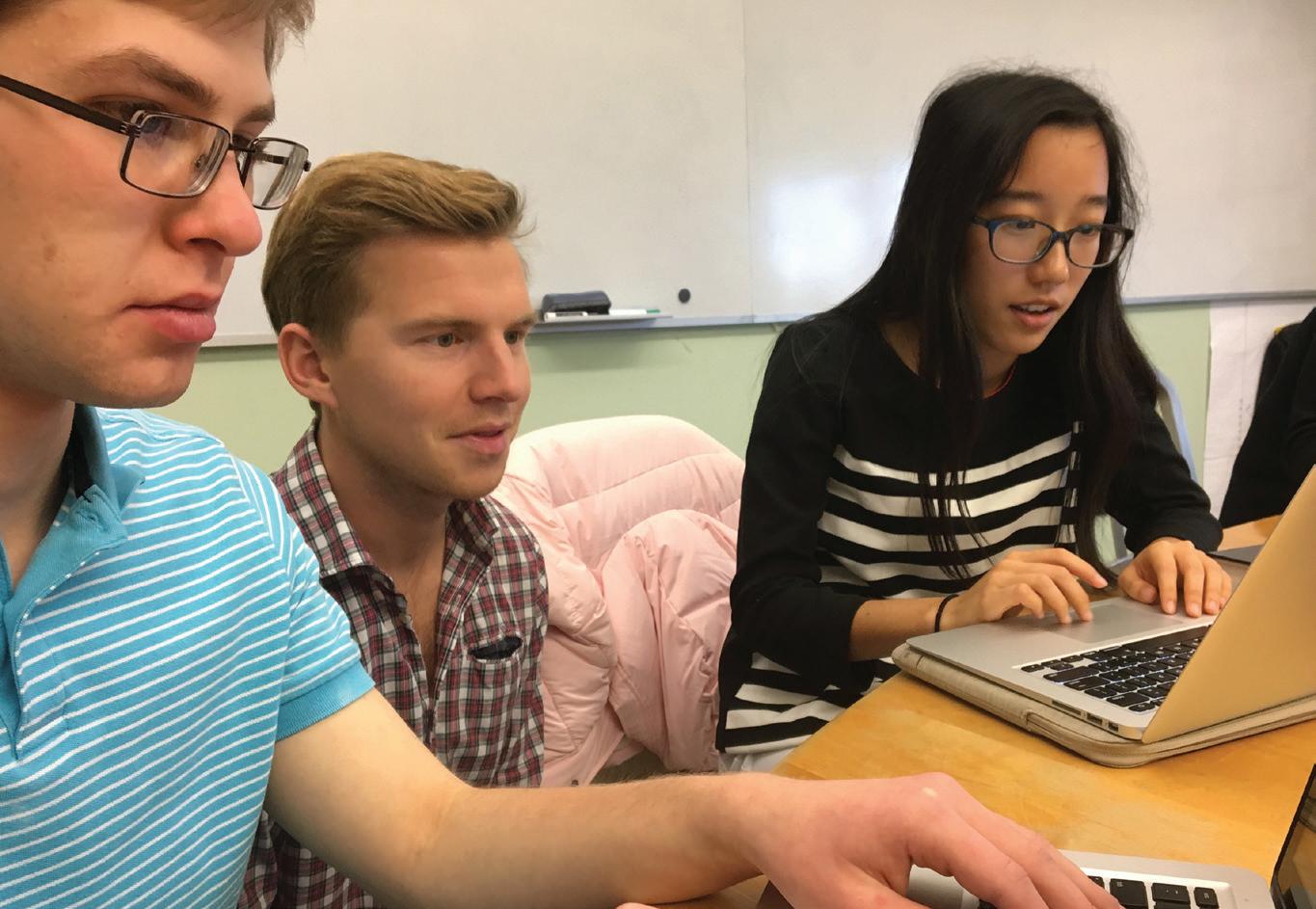
3 minute read
BRINGING THE Outside In
There is a buzz radiating from Sue Eaton’s math room on a Wednesday as two entrepreneurs engage in deep conversation with students enrolled in Entrepreneurial Studies: Using financial modeling to predict viability and sustainability of a social or edtech venture. Open enrollment seemed to be the norm, as students, not technically enrolled in the class, lingered outside or showed up to join in on the conversations and to learn from these engaging entrepreneurs.
When Rocky Hill School partnered this fall with the premier Bostonbased edtech accelerator company LearnLaunch, the learning experiences for our students proved numerous, with impact in every area of a child’s growth and development. This approach, to invite the real world into our educational environment, has amplified the impact for our students, moving from theoretical and simulation, to authentic, creationbased, purpose-driven learning. As we endeavor to develop students who are navigators in their learning, critical thinkers, active citizens, and effective communicators who are selfaware, globally minded, ethical, and innovative, we must engage them with people working on real solutions to actual local or global problems.
Innovation is first, and foremost, a mindset. Innovation relies on a set of skills and practices which emphasize curiosity, close observation, creativity, and inquiry, rather than discrete knowledge learned for the sake of recall or test taking. The tight connection to the application of new knowledge across all disciplines fosters intrinsic motivation and innovative thinking. What will our students do with what they know? How will they use deep knowledge of biology or art to impact a community, a cause, or the world?
To understand what this means, our students only need to look to the innovators they have the opportunity to meet on our campus. Whether this is through our Innovator-InResidence program, embedding a variety of artists or industry innovators into our classrooms, or giving real-time feedback to edtech and social entrepreneurs working to impact education, our community is immersed in these critical mindsets. What is emerging from inviting these change-makers into our community to work alongside our faculty and students is both powerful and palpable, and this impact can be measured.
Students are impacting the trajectory of the individuals with whom they are collaborating to solve social or economic challenges locally, as well
Students are impacting the trajectory of the individuals with whom they are collaborating to solve social or economic challenges locally, as well as globally as globally. This was evident when Marissa Di Pasquale, founder of Cashtivity, one of our edtech partners, brought her real-world experiences to our 5th, 6th, and 8th grade classrooms. With the leadership of Theresa Conroy and Caity MacDonald P’32, both veteran math teachers, the students explored the challenges designed to uncover critical mathematical functions embedded within the realworld challenge. Ms. MacDonald reflected that, “Having access to these innovators is essential for them and for us. It provides us, as educators, different ways to help our students access our curriculum, and for students, it introduces them to people that have made an idea to come to life.” In this same class, students could be heard exclaiming, “Now I know why we do this in math!”


Bringing innovators into our classrooms to work alongside students makes perfect sense and the value goes well beyond the new technology or tech tool they are creating. Our students are able to engage in authentic experiences which help them develop both the mindsets and skillsets needed to create impact, in real time. Bringing our students to real-world learning opportunities means inviting them to create, convene, and collaborate. From our student-hosted podcast series titled Engaging Tomorrow’s Leaders: Conversations with Experts, Hosted by Kids, to the collaboration with our Artists-in-Residence program with the ALEX AND ANI design team, students are learning by doing. Here is where students develop grit, become comfortable with ambiguity, and become less fearful of failure.
To illustrate the impact of these collaborations, walk into Wendy
Gustavel’s third grade classroom. As these young learners are studying the United Nations’ Global Goals for Sustainable Development, students are exploring ways to engage their community around two of the goals: Gender Equality and Health and Wellbeing. To better understand these problems, they convened Sproutel’s co-founder Hannah Chung and inventor Dr. Amy Baxter. Sproutel develops educational products such as Jerry the Bear and My Special Aflac Duck, which assist children and families experiencing health concerns. Dr. Baxter created Buzzy, a non-opioid pain management device used in hospitals and clinics globally. In this collaborative work session, Ms. Gustavel’s students acquired new knowledge, asked critical questions, and created their own prototypes, receiving feedback from real-world industry innovators. This experience not only enabled them to be active learners and creators, but is also resulting in a schoolwide collaboration to develop a new prototype Sproutel will be working on in the coming year. Hannah Chung has also joined the School as our permanent Entrepreneur-InResidence.
At Rocky Hill School, we are bringing the outside in; working to bring real-world experiences directly to our students. Collaborating with experts working to address actual problems, which rely on deep understandings across multiple disciplines, allows students to uncover the intrinsic motivation for the rigorous work required to positively impact the world. This combination of bringing the outside in, as well as bringing the learning happening inside our classrooms to the outside world, is a critical focus of the Center for Innovation as we move into a period of exponential change across all industries and academic pursuits.










